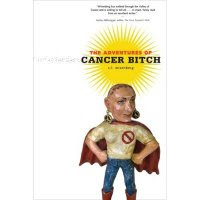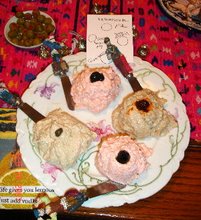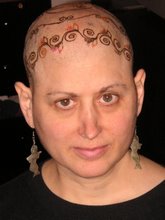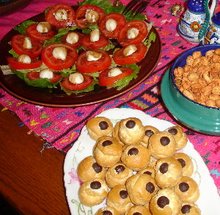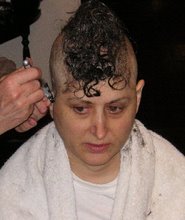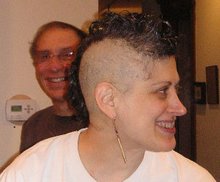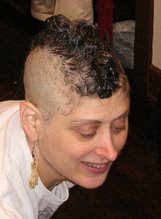Don't hit me!
Used to be if you claimed that you got cancer because you were hit there (wherever on the body there was), people would scoff. Now researchers are looking into the possibility that a blow or wound could lead to cancer, and paying special attention to the cells around tumors. If the cells are weak, they allow the cancer to spread. You can read about new respect for old ideas here in the New York Times.
Living While Black/O, the Tribune

[Is this breast black or white?]
For a while, there's been the term DWB--Driving While Black--African-American drivers report being pulled over for this offense. Now we're finding out (again) that it's dangerous to be LWB, especially in Chicago. Today's Tribune reports on a study that showed that the African-American death rate from breast cancer in 2005 was 99 percent higher in Chicago than for white women, a fivefold increase since 1990.
This is not new. Chicago Magazine reported on this a couple of years ago, or a version of this--a previous study by the same researchers at the Sinai Urban Health Institute. The same bad news: Chicago is worse than other cities. The gap between black and white health here is widening. The Trib is careful to quote an African-American doctor who partly blames the victim--the problem is partly lifestyle, she says; partly it's poverty; and partly lack of knowledge about health.
Hmm, says Cancer Bitch to herself, why is it that this is the only person in the story who's identified by race? Could it be that everyone else quoted is "normal," i.e., white, and so doesn't have to be identified?
The health study was published online yesterday in the American Journal of Public Health, the Tribune avers. It identifies Steve Whitman (no race), director of the Sinai Urban Health Institute as the author of the study. The conclusion drawn from the study, according to the journal abstract: Overall, progress toward meeting the Healthy People 2010 goal of eliminating health disparities in the United States and in Chicago remains bleak. With more than 15 years of time and effort spent at the national and local level to reduce disparities, the impact remains negligible.
You can find the abstract of the piece here. You can get the article for 30 bucks from the AJPH site.
Along these same lines, but even more depressing: A Rush University Medical Center study published in November showed that Chicago's black and white breast cancer mortality rates were the same in 1980. This was also in the Chicago Magazine story. From that piece, by Shane Trisch:
We've arranged things in this country so that the darker your skin, the shorter your life will be--Steve Whitman.
Soyoyoy

Soy has been another one of those things--unclear whether it's bane or boon to women whose tumors feed on estrogen. The reason is that soy has estrogenic properties. Thus, Dr. Keith Block, who practices integrative medicine, advises women with estrogen-positive tumors to eat soy no more than two to three times a week. On the other hand, the very mainstream oncology bigwig from Fancy Hospital said that women with estrogen-positive tumors could have soy a couple of times a day. He said this at the Town Hall meeting this fall, but he didn't quote any studies that led to his recommendation.
Now comes a study from Vanderbilt and Shanghai. Researchers looked at 5,000 women with breast cancer. They found that those with the highest intake of soy protein had a 29 percent lower risk of death during the study period, and a 32 percent lower risk of breast cancer recurrence compared to patients with the lowest intake of soy protein. Women with both E-positive and E-negative tumors had positive results. http://jama.ama-assn.org/cgi/content/abstract/302/22/2437?home=
“I would say that this study would indicate that women with breast cancer should (eat) soy products,” says Dr. Xiao Ou Shu, an epidemiologist at Nashville's Vanderbilt University Medical Centre who authored the study. “I think that it shows there is protection there.”
So bring out the edamame, which I'd been eschewing all this time, and let's cut up the tofu, which I've always maintained is the original manna.
How do you solve a problem like tamoxifen?

I take it and don't think about the side effects very often because I can't bear to. The oncologist said to take it so I take it. I know there's a chance of developing endometrial cancer, so I get checked out by the Smooth Gynecologist Who's Younger Than I Am But Acts Like She's Older. What tamoxifen does seems so direct: It cuts off the absorption of estrogen, which is what my tumor grew on. In August the New York Times told us that tamoxifen can cause the formation of a non-estrogen-sensitive and hard-to-treat tumor. And Tuesday's NYT tells of omission bias, a term for the phenomenon whereby a person worries more about a low risk of harm from something they do than about a higher risk of harm from doing nothing. In the story, the worry was about tamoxifen. The Times reported that women are afraid to take the drug. Out of 632 women in a study, 80 percent said they were worried about side effects, and most of the women said they wouldn't take tamoxifen.
At rowing practice (indoors) Monday night someone was complaining about tamoxifen's side effects, including weight gain. I feel like a fool to take it. But the good it can do is significant. Though now I read now that there's a chance of cataracts and blood clots. My polycythemia vera puts me at risk for clots, and I take hydroxyurea for the p. vera, even though the drug could cause leukemia, because the condition itself could cause leukemia, and my inhaled steroid for asthma could combine with my other drugs to make me even more liable to develop blood clots. But the hydroxyurea lowers my red blood cell count, which makes me less likely to have a clot. Red blood cells are those round red spheres in the image above.
It is a difficult, difficult thing to be alive.
The papers pile up and the news gets worse and there's another surge, the world is dangerous and the wind chill here at the moment is four below. The house is creaking from the cold. I'm wearing a flannel nightgown from Austria and L is asleep between flannel sheets with sketches of snowmen on them.
On the one hand, on the other hand, on the other other hand.

[shrug image from dreamstime.com]
Subscribe to:
Posts (Atom)
